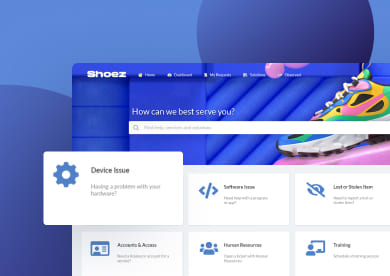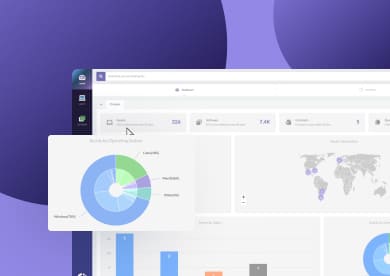The benefits of ITSM go far beyond resolving tickets efficiently — they include improved visibility, faster service delivery, better alignment between IT and business goals, and greater control over resources.
A well-structured IT Service Management (ITSM) approach can directly influence how users perceive the quality of IT support. According to MetricNet, 84% of respondents cited the service desk as the most important factor in their overall satisfaction with corporate IT services.
When implemented effectively, ITSM provides a clear framework for managing every aspect of IT operations, leading to more consistent service and measurable business value. In this article, we’ll explore the main ITSM benefits and how they contribute to creating a more productive and reliable IT environment.

10 most important benefits of ITSM
There are a lot of important benefits of ITSM. We summarize the most important advantages.
1. Fewer major incidents and faster recovery
Integrating monitoring, event correlation, and automated response workflows within ITSM processes helps detect anomalies before they become full-scale outages. Instead of reacting to disruptions, IT teams gain early visibility and a playbook for a consistent response.
The outcome is fewer high-impact incidents and lower downtime costs — often one of the largest hidden expenses in IT operations. Measuring P1 incident frequency and mean time to detect/repair (MTTD/MTTR) helps quantify this improvement.
2. Cost reduction through automation and self-service
AI chat, workflow automation, and knowledge bases built into ITSM platforms reduce repetitive tickets while improving user satisfaction. Employees get immediate answers, and agents spend less time on password resets or account unlocks.
According to Forrester TEI studies commissioned by leading ITSM platforms, organizations adopting automation and self-service within ITSM report significant cost savings, mainly from ticket deflection, ticket-handling time reductions, and productivity gains. These savings come not from cutting headcount but from refocusing support capacity on complex, high-value issues.
3. Higher change success rates and better Risk Management
Uncontrolled change is one of the leading causes of unplanned downtime. ITSM formalizes how changes are requested, reviewed, approved, and implemented, reducing risk across the board.
Defined change models (standard, normal, emergency) and automated impact assessments give teams predictability and control. Over time, fewer failed or emergency changes mean not only improved uptime but also reduced recovery costs and more stable releases. Tracking change success rates and rollback frequency provides concrete evidence of progress.
4. Stronger user experience through a reliable service desk
With a focus on delivering high-quality IT services that meet user needs, IT Service Management enhances customer satisfaction and improves the overall user experience. By ensuring timely and efficient resolution of service requests and incidents, ITSM increases user confidence in IT services.
Regular feedback mechanisms allow IT teams to understand and address customer needs and expectations, leading to higher satisfaction levels. Organizations that monitor metrics like resolution time and customer satisfaction (CSAT) see measurable improvements as their ITSM practices mature.
4. Smarter Asset Management and lower hidden costs
ITSM tools often include or integrate with a Configuration Management Database (CMDB), giving IT full visibility into hardware, software, and relationships between assets and services.
That visibility prevents overbuying, reveals unused licenses, and avoids maintenance renewals for retired equipment. Many organizations discover substantial savings once asset data becomes centralized and auditable. Beyond cost control, it also simplifies troubleshooting and compliance by showing how each component connects to business services.
5. Measurable improvement through data and benchmarking
Because ITSM structures every process — from incidents to changes — it generates consistent, comparable metrics. Dashboards showing KPIs such as CSAT, MTTR, and change success rates help IT leaders identify where service delivery falls short and where automation delivers value.
Over time, benchmarking these metrics internally or against industry data supports continuous improvement, with a feedback loop that turns anecdotal performance into actionable insights.
6. Scalable and structured processes that can extend beyond IT
A major advantage of ITSM is its scalability. The same structured processes that improve IT performance can be adapted across other business functions. This expansion, often referred to as Enterprise Service Management (ESM), allows HR, Facilities, Finance, and other departments to manage their internal services through the same consistent framework.
With ESM, every department benefits from standardized workflows, clear accountability, and shared data visibility. For instance, HR can use request catalogs for onboarding and policy questions, while Facilities teams can track maintenance tickets with the same level of traceability IT enjoys.
This consistency reduces confusion, prevents duplicate tools, and gives leadership a unified view of service performance across the organization. It also results in a more connected organization where every service operates with the same level of discipline, transparency, and measurable efficiency.
"True Enterprise Service Management means that everybody offers the same experience. When you use that portal – regardless of whether it's HR, IT, Facilities, or a print room – you should get the same level of experience from all of them."
Phyllis Drucker
Author, keynote speaker, and ESM guru
Episode 31 of Ticket Volume
7. Better vendor control and contract accountability
ITSM platforms allow organizations to manage external providers under the same service-level agreements (SLAs) as internal teams. Vendors’ response and resolution times are tracked automatically, making it easier to detect underperformance or breaches.
This transparency protects service quality and strengthens negotiation leverage when contracts come up for renewal. The result is measurable improvement in SLA compliance and a reduction in costs tied to missed service commitments.
8. Faster onboarding and smoother role transitions
Automating onboarding tasks through ITSM workflows speeds up the process from hire to productivity. Instead of manually requesting access, provisioning accounts, and tracking hardware, workflows trigger these actions automatically based on predefined templates.
The same logic applies to role changes or offboarding, ensuring permissions are properly updated or revoked. That consistency improves security, keeps assets accounted for, and eliminates delays that often frustrate new employees.
9. Stronger Knowledge Management for faster and more consistent support
Knowledge Management is a core ITSM practice that directly improves service quality and speed. By capturing solutions, procedures, and known errors in a shared knowledge base, IT teams create a single source of truth that agents and users can rely on. Instead of solving the same problems repeatedly, agents can reference documented fixes, and users can resolve simple issues on their own through self-service portals.
This shared knowledge accelerates resolution times, improves accuracy, and ensures consistency across support interactions.
Effective Knowledge Management also supports proactive Problem Management. Repeated incidents reveal knowledge gaps, prompting updates that prevent future cases. Over time, the library becomes richer and more targeted, turning documentation into a measurable performance driver.
"One of the most rewarding things is seeing people recognize the need for a knowledge article—it shows they’re thinking ahead. Half the battle is creating that awareness."
Kyle Carlson
IT Knowledge Manager at JAMF
Episode 90 of Ticket Volume
10. Faster decision-making with real-time insights
Modern ITSM platforms offer centralized dashboards and analytics that give IT leaders an immediate view of service performance. Teams can track incidents, requests, changes, and SLA compliance in real time, helping them identify bottlenecks or recurring issues without waiting for manual reports.
These insights enable more informed prioritization — for example, redirecting resources toward areas showing repeated service failures or early signs of risk. When service performance metrics are consistently reviewed and acted upon, IT evolves from a reactive support function into a strategic partner to the business.
11. Centralized Request Management for greater visibility and control
Request Management is one of the core functions of ITSM, and its value extends well beyond simply logging and resolving tickets. A centralized request management process creates a single entry point for all user needs — from password resets to hardware provisioning — ensuring that no demand is lost in email threads or informal chats. Requests are categorized, prioritized, and automatically routed to the right teams, which reduces delays and helps maintain service quality.
Standardized workflows ensure that every request follows a consistent approval and fulfillment path, improving transparency and accountability. Managers can easily track progress, monitor workloads, and spot emerging patterns such as recurring requests that signal a need for automation or user training. In the long run, effective Request Management enhances user satisfaction, reduces operational noise, and helps IT align its services more closely with business priorities.
12. Continual service improvement for ongoing optimization
ITSM doesn’t stop once processes are defined — continual service improvement (CSI) ensures that those processes evolve as the organization’s needs change. CSI introduces a structured way to review performance data, analyze trends, and implement targeted enhancements. Instead of reacting to isolated issues, IT teams work from measurable insights gathered from incidents, requests, and user feedback.
Regular service reviews and post-implementation analyses create a feedback loop where every improvement feeds into the next. For example, if data shows recurring delays in change approvals, teams can redesign workflows or introduce automation to remove bottlenecks. Over time, these incremental adjustments improve consistency, reduce waste, and raise satisfaction scores.
Using InvGate Service Management as your ITSM software
InvGate Service Management is an ITIL-aligned platform designed to improve IT efficiency, visibility, and user experience. It helps teams standardize processes, automate tasks, and deliver faster, more consistent service.
Key capabilities:
- Incident, Problem, and Change Management – Structured workflows reduce downtime and improve service reliability.
- Service request and SLA Management – Automate requests and track compliance with agreed targets.
- Knowledge Management and self-service – Centralize solutions and allow users to resolve common issues on their own.
- Workflow automation – Streamline repetitive tasks like approvals and escalations.
- IT Asset Management – Track hardware and software and link them to services for better visibility.
- Enterprise Service Management (ESM) – Extend ITSM practices to other departments like HR, Facilities, or Finance.
InvGate Service Management combines usability and governance, helping organizations deliver services with quality and consistency, while reducing operational costs.
Start your free 30-day trial today, explore all features with your own instance, and discover the impact on your IT team.















